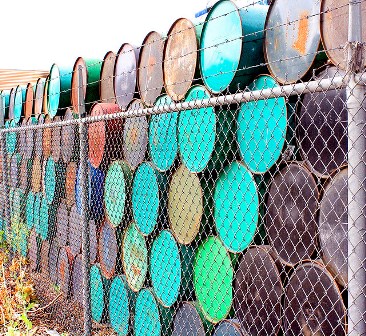Despite a world of geopolitical tension, crude oil prices have remained steady.
West Texas Intermediate (WTI) has been holding in the mid $90s, while Brent continues to trade in the low $100 range.
This trading dynamic tells us two things…
First, traders obviously do not think the crises in Ukraine, Iraq, or Gaza will have a major impact on the global market (at least not yet). As a result, they are discounting the impact of the tensions on overall availability.
Second, other hotspots â€" especially the ongoing hostilities in Libya â€" are having an immediate knock-on effect when it comes to crude supply.
In this case, traders are factoring in a couple of related dimensions â€" the lower worldwide demand that is expected this time of year, and the rise in other sources of oil â€" especially unconventional (tight and shale) production in North America.
This is causing traders to discount the impact on overall deliverability as well.
As a result, the daily news does not seem to be adversely impacting the price of oil.
Butthat doesn't mean we're out of the woods yet â€" not by a long shot…
What Really Drives Crude Oil Prices
The key here is to recognize that crude oil prices are still determined by the balance between readily available supply and existing demand. That means that even relatively small swings in either supply or demand can have an outsized effect.
It's the expectations of future changes in this balance that ultimately drives how traders view the market.
After all, these guys are attempting to deal with what the price of oil will look like months in advance. That's the very nature of futures contracts. Traders need to deal with the "uncertainty factor" in determining their contract pricing.
This factor is usually accounted for in the calculation of volatility or, to be more correct, the implied volatility. In essence, traders must compensate for how the price is likely to change one way or the other over the life of the futures contract.
To offset their risk, they take out options at a different strike price from the futures contract, which requires that a certain amount of oil be purchased at a set price and on a set date. Conversely, an option is just that, the right (but not the obligation) to do the same.
To exercise an option, the trader simply pays a premium based on a percentage of the underlying value. If it turns out the option is unnecessary, it's merely allowed to expire and the premium is the only amount lost.
In short, options are the insurance policies traders take out to hedge a futures contract. In fact, it operates in the same way your own insurance policies do: A premium is paid to protect you against major unforeseen losses.
The key to determining the cost of that premium is in calculating how much volatility to expect during the life of the contract.
That's where the element of implied volatility comes in big time.
Now, my graduate students used to complain every time I made them calculate that "implied volatility thing." But I forced them to learn it for a very important reason.
You see, most traders themselves don't know how make this calculation; they simply hit an app button on an expensive calculator!
As a result, they don't always understand what drives the most important single element in determining the insurance policy that is necessary to keep them from losing the farm.
Without understanding the calculation itself, they are blind to the real movement of volatility.
When Uncertainty Breaks the ModelNow, we certainly don't have the time to talk in this format about what can happen next other than to say this: The formulas built into those apps are very limited in their operations. They require standard market assumptions and quite artificial arrangements.
Most of the time this doesn't matter, since the likely movement one way or the other is not large enough to upset this arrangement. A trader may sacrifice some money now and then, but it is offset by the volume of contracts and options they run.
The problem is the "uncertainty factor" is discounted by a process that cannot possibly compensate if it were to hit in a big way.
This is the decisive point to remember when it comes to how a global crisis actually moves crude oil prices. As long as the uncertainty can be kept in a jar provided by an app, it's not a serious problem.
Once the lid is off the jar, however, the normal pricing structure simply cannot compensate for it. Too much uncertainty means that prices no longer conform to the artificial strictures of the math determining the cost of trading insurance (i.e., options).
In that situation, traders are forced to overcompensate in setting prices, since that's the only "real world" way to insure themselves against a catastrophic loss. They follow the direction of the pricing trend (up or down), aggravating the actual market move.
This happens because the way oil prices are determined is largely a result of statistical requirements â€" not genuine events.
And when events take over, there is no app for that.
As a result, we then end up with what I have called the "vega factor," or the increasing inability to determine a genuine value for oil based on its market price.
Remember that the market price of oil in uncertain situations is driven by the traders, not what's happening in the real world.
This doesn't have to happen often for there to be a major impact on profits. We are not there yet, but several scenarios are emerging in which we could be pushed into a "vega factor" situation rather quickly.
When that happens, I have developed a strategy to make some quick money on these events, and will discuss it in Oil & Energy Investor.
Consider it my own personal app.
More from Dr. Kent Moors: After Kinder Morgan made the bombshell announcement last week that it is abandoning the master limited partnership structure that it helped to pioneer, many feared it could be the end of MLPs. Here's all you need to know about investing in MLPs after Kinder Morgan…
Tags: Crude Oil Prices, crude oil prices today, oil price, Oil Prices, oil prices 2014, oil prices today, what drives crude oil prices, what drives oil pricesThe post How Crude Oil Prices Are Driven by the "Uncertainty Factor" appeared first on Money Morning - Only the News You Can Profit From.
